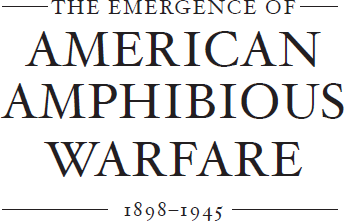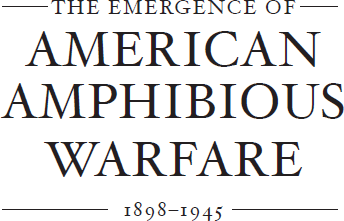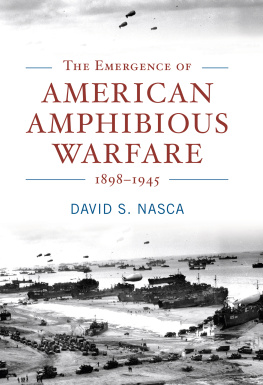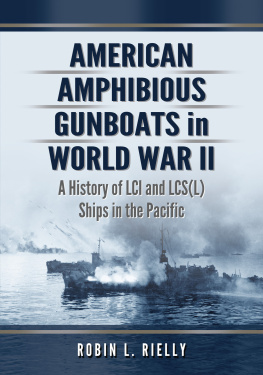David S. Nasca - The Emergence of American Amphibious Warfare, 1898–1945
Here you can read online David S. Nasca - The Emergence of American Amphibious Warfare, 1898–1945 full text of the book (entire story) in english for free. Download pdf and epub, get meaning, cover and reviews about this ebook. year: 2020, publisher: Naval Institute Press, genre: Politics. Description of the work, (preface) as well as reviews are available. Best literature library LitArk.com created for fans of good reading and offers a wide selection of genres:
Romance novel
Science fiction
Adventure
Detective
Science
History
Home and family
Prose
Art
Politics
Computer
Non-fiction
Religion
Business
Children
Humor
Choose a favorite category and find really read worthwhile books. Enjoy immersion in the world of imagination, feel the emotions of the characters or learn something new for yourself, make an fascinating discovery.
- Book:The Emergence of American Amphibious Warfare, 1898–1945
- Author:
- Publisher:Naval Institute Press
- Genre:
- Year:2020
- Rating:5 / 5
- Favourites:Add to favourites
- Your mark:
- 100
- 1
- 2
- 3
- 4
- 5
The Emergence of American Amphibious Warfare, 1898–1945: summary, description and annotation
We offer to read an annotation, description, summary or preface (depends on what the author of the book "The Emergence of American Amphibious Warfare, 1898–1945" wrote himself). If you haven't found the necessary information about the book — write in the comments, we will try to find it.
The Emergence of American Amphibious Warfare, 1898–1945 — read online for free the complete book (whole text) full work
Below is the text of the book, divided by pages. System saving the place of the last page read, allows you to conveniently read the book "The Emergence of American Amphibious Warfare, 1898–1945" online for free, without having to search again every time where you left off. Put a bookmark, and you can go to the page where you finished reading at any time.
Font size:
Interval:
Bookmark:


Titles in the Series

Progressives in Navy Blue: Maritime Strategy, American Empire, and the Transformation of U.S. Naval Identity, 18731898
Learning War: The Evolution of Fighting Doctrine in the U.S. Navy, 18981945
Victory without Peace: The United States Navy in European Waters, 19191924
Admiral John S. McCain and the Triumph of Naval Air Power
Churchills Phoney War
COSSAC: Lt. Gen. Sir Frederick Morgan and the Genesis of Operation OVERLORD
Studies in Naval History and Sea Power

Christopher M. Bell and James C. Bradford, editors
S tudies in Naval History and Sea Power advances our understanding of sea power and its role in global security by publishing significant new scholarship on navies and naval affairs. The series presents specialists in naval history, as well as students of sea power, with works that cover the role of the worlds naval powers, from the ancient world to the navies and coast guards of today. The works in Studies in Naval History and Sea Power examine all aspects of navies and conflict at sea, including naval operations, strategy, and tactics, as well as the intersections of sea power and diplomacy, navies and technology, sea services and civilian societies, and the financing and administration of seagoing military forces.

DAVID S. NASCA
NAVAL INSTITUTE PRESS
ANNAPOLIS, MARYLAND
Naval Institute Press
291 Wood Road
Annapolis, MD 21402
2020 by David S. Nasca
All rights reserved. No part of this book may be reproduced or utilized in any form or by any means, electronic or mechanical, including photocopying and recording, or by any information storage and retrieval system, without permission in writing from the publisher.
Library of Congress Cataloging-in-Publication Data
Names: Nasca, David S., date, author.
Title: The emergence of American amphibious warfare, 18981945 / David S. Nasca.
Description: Annapolis, Maryland : Naval Institute Press, 2020. | Series: Studies in naval history and sea power | Includes bibliographical references and index.
Identifiers: LCCN 2019047084 (print) | LCCN 2019047085 (ebook) | ISBN 9781682475041 (hardcover) | ISBN 9781682475058 (pdf) | ISBN 9781682475058 (epub)
Subjects: LCSH: Amphibious warfareHistory | United StatesHistory, Naval20th century. | United StatesArmed ForcesHistory20th century.
Classification: LCC U261 .N37 2020 (print) | LCC U261 (ebook) | DDC 355.4/6097309041dc23
LC record available at https://lccn.loc.gov/2019047084
LC ebook record available at https://lccn.loc.gov/2019047085
 Print editions meet the requirements of ANSI/NISO z39.48-1992 (Permanence of Paper).
Print editions meet the requirements of ANSI/NISO z39.48-1992 (Permanence of Paper).
Printed in the United States of America.
28 27 26 25 24 23 22 21 209 8 7 6 5 4 3 2 1
First printing
Maps created by Chris Robinson.
Contents

Maps

Preface

A mphibious warfare is one of the oldest forms of power projection and was instrumental in changing the course of history. It not only led to the rise of great and powerful nations; it also contributed to the downfall of others. However, the rise of science and technology brought an unprecedented amount of development in weapons and machines. As various countries scrambled to possess the means to protect themselves as well as expand their power and influence, amphibious warfare was neglected by most militaries around the world in their scramble to modernize against peer competitors and potential hostile state actors.
Despite the rise of new means of waging war, this book looks into how the old ways still work best. Amphibious warfare has often been seen as a difficult and dangerous enterprise that requires a great commitment of a countrys military and financial strength where success is not always certain. While other technologies have been embraced and utilized to sidestep this difficult form of fighting, amphibious warfare was instrumental in establishing todays international system and in transforming the balance of power.
I wrote this book because amphibious warfare has often been viewed as outdated and long past its prime in the twenty-first century where advanced aircraft, nuclear weapons, special operators, drones, and now cyber warfare are seen as the new means to how conflicts will be fought. While all these new ways of fighting do bring various military options for states, four years of research at Salve Regina University has shown that amphibious warfare was the most influential in geopolitical strategy and has done much to transform the world in which we live today. I hope this book will generate discussion and debate on the important continued role amphibious warfare can still play in geopolitical strategy.
David S. Nasca
WASHINGTON, DC
JUNE 13, 2019
Acknowledgments

T his book would not have been possible without the help of so many people over the course of four years. The beginnings of my manuscript started at the beautiful Salve Regina University in Newport, Rhode Island. The guidance, mentorship, humor, and vast knowledge of the late Dr. Eric John Shaw on the historical, technical, and strategic aspects of the U.S. military made the writing process both enjoyable and rewarding. In addition, I would also like to extend my gratitude to Dr. Michael Budd, Dr. Luigi Bradizza, and Dr. William Leeman at Salve Regina University, who went above and beyond the call of duty in taking time from their very busy academic schedules to invest their knowledge and energy in patiently reviewing my manuscript. Their insightful feedback and recommendations not only helped expand my research, but also kept me focused and on target with my arguments.
At home, I am thankful to my loving parents, Stephen Paul Nasca and Purita Mendoza Nasca, who taught me the value of lifelong learning and an appreciation for hard work. I am especially indebted to my father for the countless hours he spent with me on our mutual love of history and all things military. I would not be where I am today without him. In addition, my years of researching, writing, and traveling for this book would not have been possible without the amazing support of my family. My sister, Nikko Nasca Rice, and my brother-in-law, Shawn Rice, were a wealth of advice and support in helping me overcome the challenges in writing this book. In addition, my nephew, Braden, and my nieces, Cassidy and Halle, were my biggest cheerleaders and fans whose humor, smarts, and enthusiasm were a great source of inspiration and sorely needed fun!
Finally, the publication of this book would not have become a reality without the amazing support and work of the entire team at the Naval Institute Press. I especially want to thank Glenn Griffith, who as acquisitions editor patiently worked with me throughout the entire publication process. His guidance not only made it a fun and exciting experience, but I would also have been hopelessly lost without his help! In addition, I would like to thank production editor Rachel Crawford, as well as Mary Hardegree for her careful review of my manuscript. Her attention to detail in copyediting brought a refinement and polish to the book that makes me sound more intelligent than I really am! Next, I would like to express my gratitude to Chris Robinson for designing the beautifully crafted maps and allowing me to provide my initial input and guidance. He had to work extra hard to turn straw into gold! Lastly, I will always be grateful to all the amazing people at the Naval Institute Press who worked tirelessly in seeing this book transformed into its beautifully crafted final product. The hours they spent carefully designing and perfecting this book were the result of not only outstanding teamwork, but also a labor of love.
Next pageFont size:
Interval:
Bookmark:
Similar books «The Emergence of American Amphibious Warfare, 1898–1945»
Look at similar books to The Emergence of American Amphibious Warfare, 1898–1945. We have selected literature similar in name and meaning in the hope of providing readers with more options to find new, interesting, not yet read works.
Discussion, reviews of the book The Emergence of American Amphibious Warfare, 1898–1945 and just readers' own opinions. Leave your comments, write what you think about the work, its meaning or the main characters. Specify what exactly you liked and what you didn't like, and why you think so.







